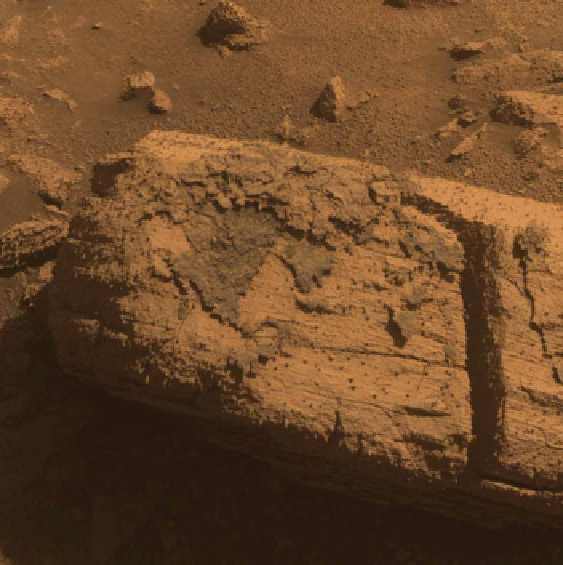Geoscience Reference
In-Depth Information
Fig. 8.13
This image from the panoramic camera on NASA's Mars Exploration Rover Oppor-
tunity shows a rock called “Chocolate Hills,” which the rover found and examined at the edge
of a young crater called “Concepción.” The rocks ejected outward from the impact that dug
Concepción are chunks of the same type of bedrock Opportunity has seen at hundreds of locations
since landing in January 2004: soft, sulfate-rich sandstone holding harder peppercorn-size dark
spheres like berries in a muffin. The little spheres, rich in iron, gained the nickname “blueberries.”
Opportunity used tools on its robotic arm to examine the texture and composition of target areas
on the rock with and without the unusual dark coating material. In some places, the layer of closely
packed spheres lies between thinner, smoother layers. The rock is about 20 cm in size. Detailed
inspection of the rock revealed a bright material filling internal cracks. Such material may have
crystallized from water trickling through the volcanic rock in a region thought likely to once
be under water. Long ago, water flowing through fractures could have dissolved the sandstone
and liberated the blueberries that fell down into the fracture and packed together. This view is
presented in “natural” color. Opportunity took the image during the 2,147th Martian day, or sol,
of the rover's mission on Mars
(
http://www.nasa.gov/mission_pages/mer/images/pia12972.html
-
NASA/JPL-Caltech/Cornell University, February 6, 2010)
8.3.9.10
Mars Reconnaissance Orbiter
The Mars Reconnaissance Orbiter's High Resolution Imaging Science Experiment
(HiRISE) instrument has taken many images that strongly suggest that Mars has
had a rich history of water-related processes. A major discovery was finding
evidence of ancient hot springs. If they have hosted microbial life, they may contain
biosignatures. Research published in January 2010 described strong evidence for

Search WWH ::

Custom Search